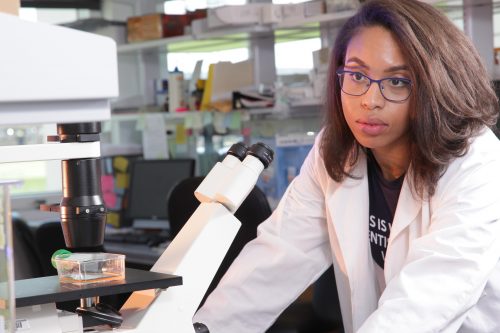When COVID-19 caused business across the United States to shut down, many young people found themselves trapped at home with an abundance of free time. Many found solace in TikTok trends like the #WipeItDownChallenge, which involves wiping a mirror and switching between two disparate appearances. For Dr. Korie Grayson, a postdoctoral research fellow in chemical engineering at the University of Michigan, the trend was a way for her to celebrate the completion of her Ph.D. “I was a little bummed out and upset that I wasn’t able to walk in person because of COVID,” Grayson said. “I was like… this #WipeItDown challenge looks kind of cool. I think it would be a cool idea if I just showed myself getting into my gown and [doing] certain swipes and wipes.” In her version of the TikTok trend, Grayson alternates between an AstroWorld shirt and her red and black graduation regalia. The video went viral, gaining likes and shares from celebrities and aspiring scientists alike. While it is not the only thing Grayson will be known for, it encapsulates the engineer’s dedication to fun and activism in her career.
Grayson’s Ph.D. research involved targeted drug delivery approaches to treat late-stage prostate cancer. Inspired by her grandfather’s passing from prostate cancer and her own predisposition to colorectal cancer, Grayson spent her Ph.D. program analyzing whether nanoparticle drugs decorated with TRAIL, a protein that can induce cell death, could target and penetrate primary prostate tumors using leukocytes, immune cells that are already in the body. “[TRAIL is] specific to cancer cells but spares normal cells,” she said. “We would use it to decorate the particle. And so… [using E-selectin, a cell surface molecule] it would latch onto leukocytes in the blood and then target and bombard cancer cells [to kill them].” She subsequently examined the interactions between her TRAIL-based nanoparticle drug and other more common therapies for metastatic cancer in 2D and 3D cultures. She found that common clinical treatments sensitized the tumors enough for TRAIL to effectively kill prostate cancer cells.
During her postdoctoral position, she hopes to extend her research to colorectal cancer and COVID-19. Acute respiratory distress syndrome (ARDS) is a deadly condition that can affect COVID-19 patients. ARDS is often caused by leukocytes like neutrophils infiltrating the lungs. “If we can preferentially target a certain leukocyte so they don’t do this… then maybe we can spare people… at that stage,” Grayson said. Grayson’s research will focus on evaluating novel nano- and microparticles for therapy in neutrophilic, acute inflammatory diseases and cancer.
Outside of engineering, Grayson’s interests include participating in Carnival, a months-long annual Trinidadian custom that reaches its peak the Monday and Tuesday before Ash Wednesday. While she herself is not Trinidadian, participating in the costuming and parties has allowed her to completely immerse herself in the cultural significance of the event as well as regain ownership of her appearance. “From an outsider looking in, it looks really raunchy and debauchery, but [it is] just a freedom of expression and sexual liberation while celebrating the traditions and culture of Trinidad and Tobago,” Grayson said. Grayson carries this mindset to all aspects of her life as a tattooed Black woman in STEM, pushing back against the notion that scientists must look a certain way in order to be seen as professional. “We’re multifaceted. We don’t necessarily fit the stereotype of just being buttoned up, geeky, nerdy,” Grayson said. “We also can wear bathing suits, we also can go have fun, we might drink a little, we have tattoos, we have piercings.”
Grayson stresses the importance of visibility when it comes to pursuing a career in STEM. “One of the main reasons why women don’t remain in STEM, especially women of color, is because we don’t have that representation, and we don’t see it,” she said. This is evident in the statistics: according to a 2015 survey by the National Science Foundation, Black women make up less than ten percent of the STEM workforce and less than four percent of STEM-related doctorate programs. Additionally, sexism continues to be a barrier of entry for aspiring female scientists, as proven by a recent controversial manuscript in the Journal of Vascular Surgery that declared wearing bikinis to be “unprofessional behavior” for scientists. By pushing back against the article’s policing of what female scientists should and should not wear, Grayson combats this misogyny.
Ultimately, Grayson aspires to not only succeed in her research but also to show Black women that success in STEM is possible for people who look like them. “My purpose here is greater than me,” Grayson said. “It’s about growing and inspiring and helping other people get to where I’m at and beyond.”
To hear more about Dr. Korie Grayson, check out her Twitter/Instagram page at @teamkorie and her website at koriegrayson.com.

